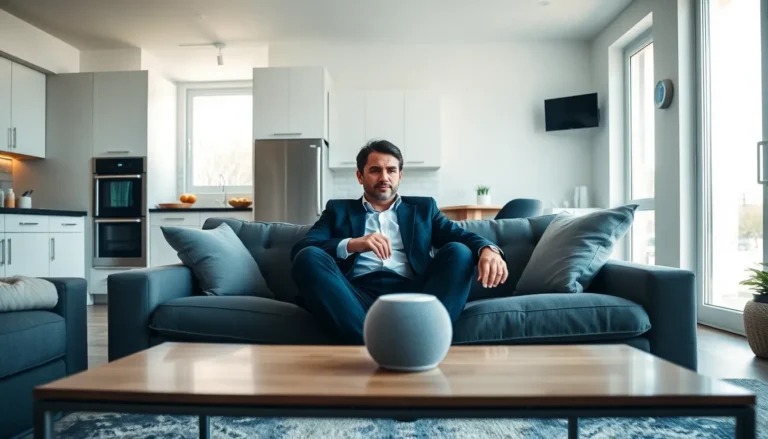Picture this: you’re walking through a park, and suddenly, a puppy zooms past. Instantly, you recognize it as a dog, not a fluffy potato or a tiny wolf. This remarkable ability to interpret and make sense of sensory input is all thanks to perceptual organization. In this text, we’ll investigate into this fascinating topic, explore its principles, and laugh a little along the way. After all, understanding how our brains piece together the jigsaw puzzle of reality isn’t just interesting: it’s downright crucial for navigating our daily lives.
Table of Contents
ToggleUnderstanding Perceptual Organization

Perceptual organization refers to the process by which individuals arrange and interpret sensory stimuli to achieve a comprehensive understanding of their environment. Each day, our brains face the challenge of processing an overwhelming amount of information from the world around us. From the vibrant colors of a sunset to the bustling sounds of a city, the brain meticulously organizes these sensations into recognizable patterns. This complex phenomenon can be likened to assembling a jigsaw puzzle, every piece of sensory information fits together to create a complete, coherent picture. When we grasp how perceptual organization works, it enhances our appreciation of art, cognition, and the very way we interact with the world.
The Principles of Perceptual Organization
Several foundational principles define how perceptual organization operates. These principles allow the human brain to simplify complex stimuli, leading to more effective interpretation. Here are some key concepts:
The Law of Proximity
Objects that are close to each other tend to be perceived as a group. For instance, think about a flock of birds flying together. Our brain automatically recognizes them as one entity, a flock, because of their spatial closeness.
The Law of Similarity
Similar items are grouped together in perception. For example, if colored dots are randomly placed on a surface, those of the same color will be perceived as belonging together.
The Law of Closure
Our minds have a natural tendency to fill in missing pieces to form complete shapes. Imagine a circle that’s almost complete but has a small gap: our brain will visualize it as a complete circle.
The Law of Continuity
We perceive lines and patterns as continuous rather than disjointed. If two lines intersect, our brain will follow the smoothest path rather than the abrupt angle created by their intersection.
These principles work together to help individuals make sense of the world swiftly and efficiently.
Factors Influencing Perceptual Organization
Perceptual organization is not merely a mechanical process: several factors influence how individuals interpret sensory stimuli. Understanding these factors provides insights into personal and cultural variations in perception.
Context
The surrounding context significantly affects how people interpret information. If a person sees a pumpkin near a pile of leaves, they might associate it with Halloween. If placed on a farm, it might evoke thoughts of harvest time. Contextual cues guide perception by anchoring stimuli in specific interpretations.
Experience
Past experiences shape how individuals organize and understand sensory information. For example, a seasoned musician will perceive and interpret musical notes differently from a person with little exposure to music. Their unique experiences alter the way they categorize information.
Culture
Cultural backgrounds can influence perceptual organization. Colors, shapes, and symbols may have different meanings across cultures. A red light stops drivers in many regions but symbolizes celebration in some cultures. Recognizing these cultural significances can lead to more informed interpretations.
Applications of Perceptual Organization in Daily Life
Perceptual organization is more than just a cognitive curiosity: it has practical applications in everyday life. From the way we navigate city streets to how we interact with technology, understanding it can enhance experiences.
Navigation
When exploring new areas, perceptual organization helps individuals identify landmarks, street signs, and other essential information, enabling swift navigation. For instance, when walking in a new city, one’s ability to recognize familiar shapes helps maintain orientation and enhances the overall experience.
Communication
Effective communication relies heavily on perceptual organization. When interpreting gestures, facial expressions, or tone of voice, individuals organize this sensory input to form meaningful interactions. Our ability to read social cues hinges on understanding the nuances of perceptual organization.
Marketing
Advertisers leverage perceptual organization principles to design visually appealing and effective campaigns. By grouping products, using color schemes, and ensuring continuity, they create ads that catch attention and communicate messages clearly. This understanding of perception can make or break marketing efforts as it influences consumer behavior.
Perceptual Organization in Art and Design
Art and design are deeply intertwined with perceptual organization principles. Artists and designers intuitively rely on these concepts to create captivating and impactful works.
Composition
In visual arts, composition dictates how elements are arranged within a piece. By applying laws of proximity and similarity, artists can guide viewers’ eyes through their work, creating a visual path that enhances understanding.
Color Theory
Understanding how colors interact plays a pivotal role in design. Designers use perceptual organization principles to create harmonious palettes, ensuring that colors work together effectively, leading to an aesthetically pleasing outcome.
User Experience (UX)
In the digital realm, UX designers apply perceptual organization to create user-friendly interfaces. By organizing information logically, utilizing consistent layouts, and implementing intuitive navigation, they enhance users’ interactions with technology.
Challenges and Limitations in Perceptual Organization
Even though its remarkable efficacy, perceptual organization faces challenges and limitations. These barriers can distort perception or lead to misunderstandings.
Perceptual Biases
Individuals may bring biases into their perceptual organization. For example, confirmation bias can lead people to only recognize information that supports their beliefs while ignoring contradictory evidence.
Visual Overload
In environments saturated with stimuli, such as busy streets or colorful advertisements, the volume can overwhelm perception. It may result in confusion and errors in interpretation, emphasizing the need for clarity in design.
Variability in Perception
Different individuals perceive stimuli differently, influenced by factors such as age, culture, and individual experiences. This variability can lead to misinterpretations and emphasizes the complexity of perceptual organization.



